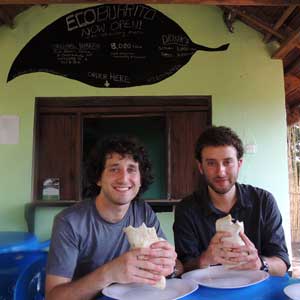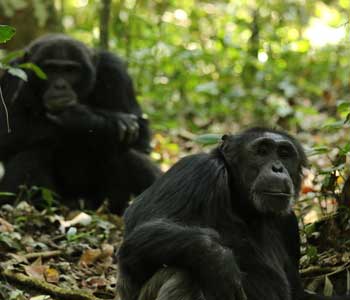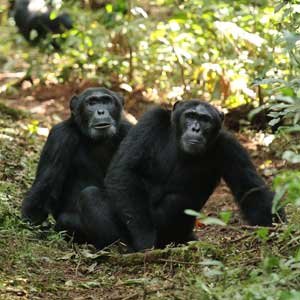Call of the wild
U-M doctoral student Aaron Sandel trudges through a dense Ugandan jungle, listening for the calls of wild chimpanzees. He often spends up to 12 hours a day doing this, tracking the animals to thorny patches and swamps. It’s mostly quiet work. Peaceful. And sometimes lonely.
The solitude certainly gives him time to contemplate the questions at the core of his research. What does it mean to transition from adolescence to adulthood? And how does one embrace new behaviors, independence, and responsibilities?

Django buttresses drums to find other chimps. The noise helps Aaron Sandel and Nathan Chesterman track the animals. (Photo by Nathan Chesterman.)
Sandel hopes to find the answers by studying when and how adolescent chimpanzees forge friendships, an important aspect of adult chimpanzee life. He has been living in the center of Kibale National Park since August 2014, watching – but never interacting with – his subjects.
“For their own safety, we stay around 20 feet away at all times,” Sandel says. “That’s how I show my friendship — by keeping my distance and trying to be an unobtrusive observer.”
He spends so much time observing the chimps, he says, “I forget I’m not part of their lives.”
Fortunately, Sandel has a “forest friend” in colleague Nathan Chesterman, a 2014 U-M graduate with a double major in biopsychology and evolutionary anthropology. Chesterman photographs the young males to determine when they stop growing. He also collects their urine for hormone analysis.
“These hours I spend in the forest can vary from incredibly fascinating to incredibly dull,” Chesterman says. He joined Sandel to gain field experience and clarify his own career objectives.
For his part, Sandel is grateful for the company. “It helps to have another human around,” he says.
Each day the pair enters the forest by 7 a.m. in search of the chimps, which can take 30 minutes or a few hours. Chimpanzees live in communities, but they split up into subgroups throughout the day, so finding them can be difficult. The researchers listen for the loud calls chimpanzees use to communicate; they track them down, record as much data as possible, and by 7 p.m., they return to their camp.
This has been the routine of many people from the University of Michigan for more than 20 years.
Decades of primate research
In 1995, two years after Kibale became a national park, U-M researcher John Mitani started the Ngogo Chimpanzee Project with his collaborator, David Watts, who is now a professor at Yale University.
“The relevance of our work is to understand humans,” explains Mitani, a primate behavioral ecologist in the Department of Anthropology. “Part of our motivation to study chimpanzees lies in the fact that they are our closest living relatives. Thus, understanding their behavior is likely to shed light on our own.”
This summer marks the 20-year anniversary of the Ngogo Chimpanzee Project’s continuous observations of chimpanzees. Over these decades, numerous insights have emerged from Ngogo: Chimpanzees kill chimps from neighboring communities to expand their territory, they share meat with their friends, and male chimpanzees have enduring social bonds.
Research on primates in Uganda dates back even further. In 1970, Tom Struhsaker, a Lansing native who is an adjunct professor at Duke University, initiated research in Kibale Forest and spent nearly two decades living in the park conducting research on red colobus and redtail monkeys. He also assisted colleagues, including former U-M professor Richard Wrangham, to set up long-term studies of chimps.
But the animals are not the only source of fascination for Kibale researchers. There is a long history of scholars working with human residents in the local communities as well.
Classrooms and community

Nathan Chesterman is updated on the school’s progress by a local resident, Alfred. (Photo by Aaron Sandel.)
In 2009, Ngogo Chimpanzee Project researcher and former U-M lecturer Brent Pav, who obtained his PhD in anthropology in 2013, began work with Kyakagunga (pronounced “chah-kah-goongah”) Primary School. At the time there were only mud structures, but Pav raised funds to build permanent classrooms. Now a fundraiser is underway for two new classrooms and an office to meet the needs of the growing school, which has 170 students.
These new buildings are necessary to apply for government funding. Currently, school fees are required to cover teacher salaries, which many parents cannot afford. With state support, trained teachers paid by the government will be deployed to the school, and education will be free to all students.
The construction costs $30,000, and organizers have raised $25,000. Construction began in June and should be completed by fall.
“We want to improve access to education so that more people can understand why they must protect the forest, and so they can learn the skills and knowledge they need to make a living sustainably,” says Chesterman.
The future of the children and the forest depends on education, adds Sandel, who will finish his research at Ngogo in September 2015.
“I want to leave knowing I made a real difference to the community,” he says. “It was my childhood dream to study apes in the wild. The least I can do is help these children achieve their dreams.”
U-M doctoral student Doreen Kembabazi has been one of those children. She is writing her thesis about the lives of women and youth during Idi Amin’s regime in Uganda during the 1970s. She is from a small village near Fort Portal, Uganda, and recalls going to a school similar to Kyakagunga, where many poor students attended.
“The pupils don’t have shoes, rain gear, books, lunch, or sanitary items,” she says. “The schools reflect the realities of the home.”
Yet they remain resilient. Kembabazi notes that every small improvement to education in this region has a huge impact.
Saving primates from poaching)
Improving education will also help the forest, Sandel says. Illegal poaching has been a longtime problem within the park. Chimpanzees sometimes fall victim to snares, which are set for antelope and other preferred bush meat. As a result, many chimpanzees have missing fingers, hands, and feet. The Ngogo Chimpanzee Project has two anti-poaching teams that patrol the forest to remove snares.
Poaching is part of the larger problem of poverty in the rural villages surrounding the forest. Unemployment is high, and many people are farmers unable to earn adequate incomes.
“Without high-quality education, people do not understand that poaching is an unsustainable source of income, and that it negatively impacts the ecosystem that the communities rely on,” Sandel says.
Burritos – yes burritos – aid in conservation efforts
In April, Sandel, with the help of Chesterman, opened a community conservation burrito restaurant in a village outside the forest. The restaurant, EcoBurrito, operates in a gazebo next to a community-run wetland sanctuary. The vision is that all net profits will go to conservation and biodiversity projects.

Nathan Chesterman and Aaron Sandel find a way to blend biodiversity and the EcoBurrito in Uganda. (Photo courtesy of Aaron Sandel.)
“All the foods are local and familiar, but people here have never tasted them together,” Sandel says.
Sandel admits it may seem strange for a primatologist to open a burrito restaurant, but he sees EcoBurrito as inextricably linked with his interests in primates, conservation, and education.
“If we make enough profit from the burritos, we hope to buy a tortilla press,” Sandel says. “I think that will really have a positive impact on the burritos and, in turn, the chimpanzees.”
The work of Sandel and Chesterman makes Mitani proud because it shows how members of the younger generation are socially conscious and “want to do the right thing.”
“What’s really gratifying is seeing the students do their own research and helping people beyond the chimpanzees they study,” Mitani says. “These students are doing terrific work.”
For additional information or to make a donation to support education and ape conservation in Uganda, visit the Ngogo Chimpanzee Project.







Shasta Johnston - 2010
I think what you’re doing is amazing. I wish I could go back in time and be more directed while in college. I am a RN but my true passion lies with animals and nature. I would love to be a part of something like this. Keep living your dream no matter the price so you have no regrets down the road.
Reply
Jesse Turner - 2006
Shasta Johnston (& others), there are some great opportunities for complementary work. Check out HealthinHarmony.org. This organization works at the nexus of conservation & health. I’ve served with them as a physician the past several years, and it’s been wonderful. I expect they’d love to have you involved, and they aren’t the only ones. Or, maybe I’ll find myself working for you one day on the idea that’s just coming to your mind.
Reply
Caroline B Smith - 1957
Yeah, John Mitani, you have some spectacular students doing good things.
Reply
Jeanah Hong - 1998 and 2010
I took a couple of Prof. Mitani’s courses in the mid 90’s and dreamed about doing this! Sounds amazing and incredible and I hope to hear more about your successes working with and studying the chimps and with the school.
Reply
NYAKAANA ANDERSON - 02 Years
A couple of years ago, I took time to read about chimpanzees and just got fascinated and interested in their everything. I love what Aaron Sandel is doing in Uganda. These are really good thing and reflect good life.
I think what they are doing is great and amazing. I would love to be part of something like this.
Reply